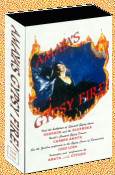![]()
Amaya's Gypsy Fire Video
A review by Ma*Shuqa
Mira Murjan
July 8, 1998
We are introduced to the "joie de vivre" of the Gypsies as
we see an elderly Gypsy woman, high on a roof top in Spain, dancing acapella to her own finger snaps. She
says, "I love to sing and dance, every knows me. And they say, Rosa, sing and dance for us. And
off I go like the errant Gypsy. Do you know what "errant" means? Tinkers, gypsies that go from place to place. My grandfather, my grandmother, my father,
my mother we wandered from town to town in a wagon. That's my life."
go from place to place. My grandfather, my grandmother, my father,
my mother we wandered from town to town in a wagon. That's my life."
In December 1997, Amaya visited the world-famous Alhambra Palace in Granada, Spain with it's multitude of waterways, fountains
and gardens. Amaya provides a historical perspective and background that surrounds the romance of the Alhambra.
As you follow Amaya through a walk through the gardens she gives an historical accounting of the Arabic influence
in southern Spain, or "Andalucia."
Next Amaya provides a history of the Gypsy Rom and how their dance was
synthesized in the South of Spain and contains influences of their origins from the countries of Libya, Algeria,
Tunisia, and Morocco. We are treated to a Gypsy Rom dance section which begins with a brief glimpse of the
famous Gypsy Flamenco singer "Chocolate." Note that the music is akin to Arabic music, but the
difference is in the performance which allows anyone of any age, any size or stature to be beautiful performing
this Spanish Gypsy Dance.
A section on Gypsy dancing in the authentic Sacramonte, a neighboring village set
into caves in the hills near the Albaicin is featured. Today, Gypsy Flamenco shows can still be enjoyed
there inthese caves. As you listen to Spanish-inspired music written for Amaya, Amaya points to the family photographs
of the Amaya family on the walls of a Sacramonte cave dwelling. It is then you understand the deep connection
and influence of Gypsy Flamenco dance in Amaya's dance
performance style.
We can enjoy a performance by a boy of about 10 years of age who
performs a Gypsy Flamenco dance with a cane, tapping out the rhythms. Amaya gives us the history of the Zambra
Mora dance that originated with the legendary performer, Carmen Amaya. "Zambra Mora provides the
dancer with the freedom of passion to combine dance into a joyous moment." says Amaya. Amaya says,
"The age of a dancer is of no consequence, in fact, life expression is revered. Emotion and passion
are required in it's (the dance) presentation." There is much that the orientale dancer can learn from
watching the passion created by the dancers as they dance using these techniques. A solo dancer shows passion
while she dances using only slowly moving arms and no footwork at all. A teenager displays his talent with lightening
fast spins and dramatic use of arms and poses.
The late Cruz Luna, a flamenco artist of the San Francisco Bay Area
in California, presents us with a distinctively unique performance. Cruz wears a white riding outfit with
white chaps, white hat and boots, dancing with a riding crop and displaying a dance based on the rhythmic patterns
of a horse's running gait. Flamenco is described aptly as "controlled passion," says
Cruz Luna. Wonderful close-up shots of Cruz show the artistry and grace in his intricate footwork.
Carmen Amaya is shown in movie posters and news photos from the 1930's.
Amaya provides rich description of this dancer's early background as a performer alongside her father in the cabaret's
in Barcelona and chronicles her worldwide performances through the 40's and 50's. Carmen dances and fixes
the audience with her signature gaze and uses attack and force which is
characteristic of the gitano style.
The last section of the videotape features lessons by Amaya in dancing the Zambra Mora steps and learning the Spanish
Gypsy style. Amaya explains how the drama and movement of Spanish dance can enliven an orientale dance.
She provides guidance on the use of the zambra mora steps in orientale dance. She dances during the narrative
explanation and by the time the lessons begin I
know that you too will be excitedly up on your feet ready to learn the movements of the zambra mora. Amaya
says: "Go ahead, let us peek into your soul."
Finally, there is a spectacular performance of Amaya in Austin, Texas to the band called "The Gypsies".
She shimmies with the fan performing the flamenco shimmies that she taught in the lesson portion of the videotape.
She shows the isolation as she shimmies and her head
remains stationary-and the audience can be heard going wild with zagarheets. When one of the members of the
Gypsies band gets up to dance to drum beats, Amaya takes up his drum and plays for him! The dance goes on
with even more shimmies on top of spins and poses and by now the
viewer is breathless with the excitement that Amaya's dancing generates.
My words cannot begin to describe the passion of dance performances on this video, Amaya's Gypsy Fire.
This video is a "must have" for your collection and dance study.